Posts Tagged flowers
Discovering the Best Flower Bed Ideas for Your Home
Flower bed ideas are typically broken down one of two ways – by the color(s) that you’re going to be using and, secondly, by the kinds of materials you might use to bring your flower ideas to life (e.g., wheelbarrow flower beds).
Monochromatic Flower Beds
Monochromatic is a blend of two words – mono, which means one, and chromatic, which refers to color. Monochromatic flower beds are designed from blooms that are all the same color.
A monochromatic flower bed can add a splash of color to your outdoor landscape, and the thing to bear in mind is that, although everything will be one color, you can use various shades and textures to create a stunning effect.
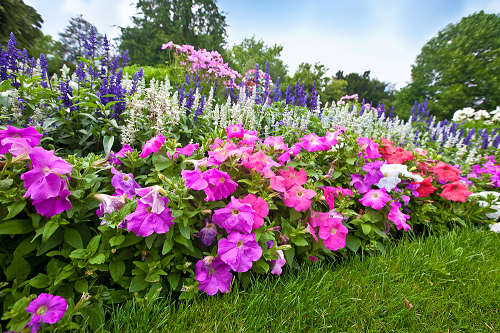
Purples and yellows are very popular variations when it comes to monochromatic flower bed ideas.
With a purple monochromatic flower bed, you have a lot of beautiful flowers to choose from: lavender, sage, leather flower, hydrangea, and grape hyacinth. A walkway lined with lavender can be absolutely breathtaking.
A yellow color scheme is also a popular choice for monochromatic gardens. Yellow gardens let you blend in deep golden hues with paler flowers with an almost buttery accent.
The Denver Daisy – a.k.a., Black-eyed Susan – and marigolds are great for adding deeper shades of yellow to a backdrop of a more mellow flower like the annual nasturtium.
Keep in mind that blues, whites, and violet flowers will have a more calming effect in your garden whereas warmer colors like red and yellow can create instant excitment!
Dichromatic and Ombre Flower Bed Ideas
Dichromatic means two colors wheras ombre is a French word that means you’re going to be using a blend of colors that gradually blend in to each other.
If you only want to use two colors, with varying shades of each color, then you probably want to look into a dichromatic garden. You’ll also want to consider using contrasting yet complementery colors to create the most powerful aesthetic look.
If you’re feeling more adventurous, then an ombre flower bed might be the way to go. Ombre flower beds typically blend some of the cool hues and warm hues discussed above to gradually blend in flowers with a lighter hue with dark hues.
An ombre flower bed typically starts off with a walkway made of flowers of a cooler, softer hue so that the eye gradually gets more and more captivated with the darker tones at the back of the garden.
Wheelbarrow Flower Garden
Sometimes called wheelbarrow planters, a wheelbarrow flower garden can be made using a wheelbarrow that’s rusted-out, cracked, or has a broken wheel.
The wheelbarrow, though, should have holes in the bottom to allow excess water to drain out. The big benefit to a wheelbarrow flower garden is that you can move it to an area with more sunlight.
Walkway Flower Beds
As alluded to above, a walkway flower bed can be a wonderful segue into a captivating garden or a landscaping effect all its own.
Millions of homeowners have already beautified their homes with a walkway flower bed culminating with their front door.
Walkway flower beds actually touch on a difference with gardens in general – a walkway flower bed would be an example of a formal garden path with right angles and straight lines.
That said, a walkway flower bed could open up into an informal pathway kind of garden (the second type) where you would have a meandering or curved path. A crescent-moon type of garden in the front yard would be an example of this second type.
Which flower bed ideas appeal to you most? Contact us for more information.
Four Creative Flower Bed Ideas to Get You Going
Creating sensuous textures and adding color to your garden with a flower bed is one of the quickest ways to improve your yard. And when it comes to flower bed ideas, there’s virtually no limit.
Raised flower beds are getting a lot of attention lately because they’re easier to water and maintain, but that’s far from the only option.
Other options are flower beds that encase trees and create a truly picturesque effect, flower beds that line a walkway to a backyard oasis, and tall flower beds filled with azaleas and wisterias.
Flower Beds Encasing Trees
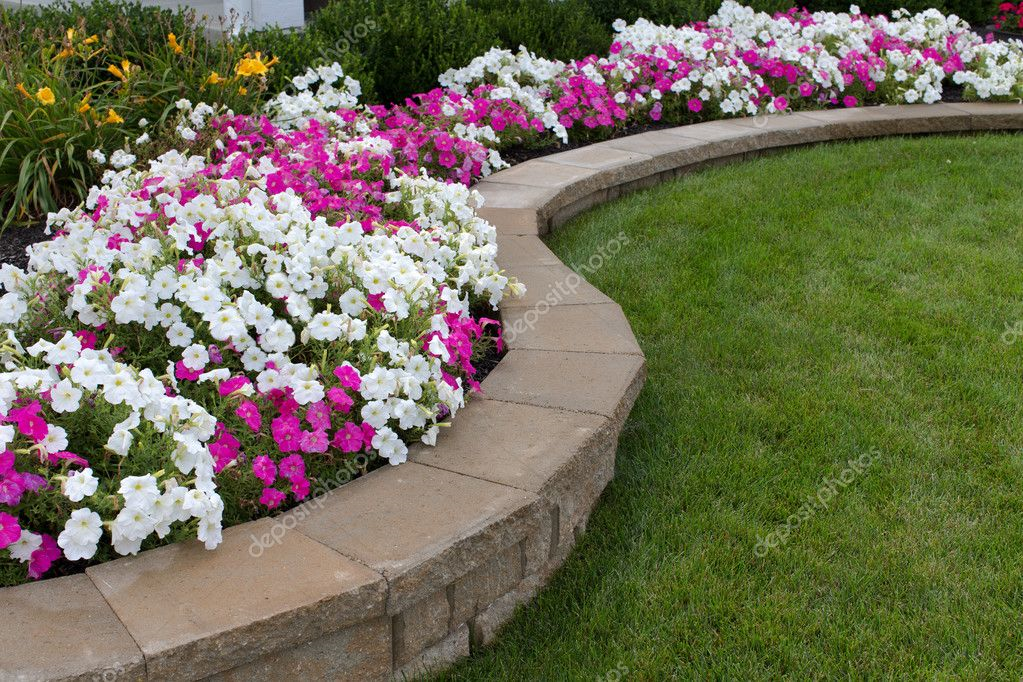
The thing to do when planting flower beds around trees is make sure that you’re selecting the right flowers for your particular region and getting the amount of sunlight versus shading right.
Plants and flowers that are “full sun” are the easiest to work with since they can receive six hours or more of sunshine per day and still be fine.
Yarrow, tickseed, and blanket flowers are all full sun plants that go great around trees. Lavender (purple) and sasha sage (white) pair well together and are both full sun plants. These might well give you the effect you’re looking for.
Circular Flower Beds
If you’re feeling a bit more adventurous, then you might want to consider a few of the flower bed ideas below (including this one!).
Circular flower beds are good if you have a huge tree that you want to draw attention to or a bare spot in your yard that needs a bit more color.
Taking an eclectic approach that gives you a wide palette of color is usually the way to go when it comes to creating a successful circular flower bed.
Bulbs, annuals, and perennials with a nice border flower like garanium can really frame things nicely. Putting something like a bird bath in the center is also an option.
Like these flower bed ideas but feeling overwhelmed with actually pulling them off? Get in touch with a landscaping company that can help you design, build, and maintain your flower bed for years to come.
Flower Beds Along a Walkway
As far as flower bed ideas go, this one’s right up there in popularity with raised flower beds and flower beds around trees.
Flower beds lining your walkway can significantly increase your curb appeal as a homeowner and work well with condos and receptions as well.
In terms of design, planting decorative flowers as a border along your walkway is said to soften the sameness and artificiality of concrete.
A line of flowers adds an unexpected splash of color in an unlikely, though not unwelcome, place.
Landscaping and design experts say to go with flowers that are hardy yet vibrant like mahogany bugleweed (purple) or red ruby.
A landscaping company can plan, edge, and till around your walkway to get things started on the right foot. Composting, mounding the soil, and actually planting the flowers comes next.
Here too landscapers can provide regular maintenance and put your flower bed and lawn on the irrigation and aeration schedule that both need to flourish and bring your outdoor landscape into full color.
Slanted Flower Beds
Slanted flower beds are one of those creative flower bed ideas that’s certainly not right for everyone but could be perfect for many people.
If your front yard is pitched, for instance, a landscaping team can help you raise your dirt bed to level and create a retaining wall that maximizes your flowers’ blooms while minimizing soil compaction.
Grasses and succulents are smart choices for sloped gardens. Contact a professional landscaper to make it happen!
Winter Plants – Part 2
During the winter season creatures prefer to hibernate and wait until nature affords them the opportunity to venture out into warmer conditions. There are no different to us humans as we seek to make our homes warm and comfortable during the dreaded winter weather. Your garden is certainly apart of your home and you should do all in your power to ensure it can handle winter’s fury and look its best. Vibrantly colored winter plants or even winter vegetables can enhance the life of a damp gloomy landscape.
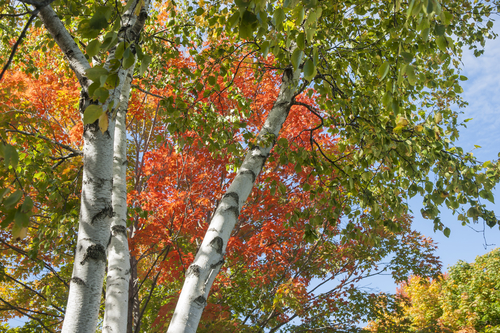
Know Your Winter Plants
An uncommon but very fascinating winter plant is Harry Lauder’s Walking Stick or Corkscrew Hazel. Even though, this shrub flowers in the spring season, it is a beautiful winter plant. This is due to its coiled and zigzagged branches. This plant tends to grow better in a fusion of bright sunlight and shade. The branches will need frequent trimming to preserve its attractive appearance however when they fall they can resemble an overgrown untidy mesh of wood.
The Paper Birch tree displays its gorgeous yellow leaves in autumn. However, when it gets extremely cold, its white bark provides a sensational difference to a backdrop of evergreens. Frequently they are used during the Christmas holidays in many gardens. The paper birch tree should be planted in deep holes with mulch to keep it damp. Partial sunlight will be essential for this plant.
The Heather plant is another suitable winter plant. It flourishes all year round and provides attractive flowers in summer and fall. It’s rich foliage provides a fascinating difference when compared to other winter plants. You should plant these in winter with mulch in an area that obtains excellent sunlight.
Holly has always been linked to winter and there are 400 assortments to select from ranging from small to gigantic trees up to 80 feet. There are various types of the holly plant to fit every garden and winter scenery. Its vibrant berries and dense foliage make it very eye-catching.
Hellebore is another winter plant that can be obtained in a fusion of selections. When flourishing it has a cup like shape and they come in an array of colors making it easy to find a color that best suits your winter garden. This plant flourishes better in total shade. Contact us for more information on how you can make create the perfect winter landscape.
Narrow Walkway Flower Bed Ideas
Flower bed ideas can be quite easy to implement. Most gardens have walkways that are about two feet wide. Narrower walkways may help you to use a small space more efficiently.
However, they pose a unique design challenge to gardeners, landscapers and homeowners: how can you create and position flower beds so that they don’t visually overpower the walkways? Try these flower bed ideas to add variety and beauty to your space.

Perennial and Evergreen Flower Bed Ideas
Narrow walkways limit access to your flower beds, and make maneuvering through the space more difficult. Annual plants are flower bed ideas that can create headaches due to yearly replanting. By choosing perennials suitable to your climate, you’ll ensure that your plants come back each year and minimize the amount of work you (or your landscapers) must do.
You may also put evergreen plants on your list of flower bed ideas. These come back each year, and the plants won’t lose their leaves or fade in ways that require additional maintenance.
Keep Flower Beds Controlled
If your flower beds grow weedy or otherwise out of control, they can cut into your walkway. Normally that may be unsightly, but not a disaster. But if your garden’s walkways are narrow, this can make the pathway difficult to navigate, or even find. This is particularly problematic with gravel or dirt walkways, where the edges are already, often, poorly defined.
When going through your flower bed ideas, make sure that the line between the flower bed and the path is clearly marked. You may want a small fence, stone wall or other raised marker. Make sure your flowers are semi-regularly pruned back from the edges of the path, and that any weeds are removed. You may want to choose plants that grow more slowly, and that put off fewer vines or shoots for you to have to deal with.
Use Trellises
Trellises and fences are perfect flower bed ideas for climbing plants, that allow you more room to play. Be sure to choose climbing plants that don’t grow to too tall of a height, to minimize maintenance. Many vines are invasive, as well, so be sure that your final choice is native to your area.
Create a Unique Environment
Finally, once your flower beds are complete, your garden may feel crowded. Take advantage of this by creating a unique atmosphere. Delicate lighting along the edges of your path, or hanging from trees, can create a mysterious atmosphere like an enchanted forest. A little fence around the whole space, along with a gate, is one of those flower bed ideas that can make your garden feel like something out of a fairy tale.
Conclusion
When you want to implement your flower bed ideas, it’s time to call an expert. Contact us for a consultation about your yard and its specific needs, including repair, maintenance, irritation, and xeriscaping for saving water.
7 Gorgeous Flowering Shrubs for Shade
A shady yard doesn’t have to stop you from having a gorgeous, lively landscape. Flowering shrubs that thrive without direct sun are a perfect choice for jazzing up your landscape, and there are many varieties to choose from. Here are our top 7 choices for flowering shrubs that work well in Zone 9:
Oakleaf Hydrangea (Hydrangea quercifolia species)
With its spikes of beautiful white flowers and distinctive oak tree-shaped leaves, this shrub attains an impressive height and width of six to 10 feet and is partial to moderate shade. In late summer, its blooms change to a pinkish purple, and come fall, the leaves take center stage and put on an impressive show of orange-red, purple and brown, which lasts well into winter.
Rhododendron (Rhododendron species)
A shrub with its own fan club, there are more than 900 species of the Rhododendron. Most grow to a height and width of eight to 10 feet, bloom in late spring, and then present attractive foliage after that. This is the shrub to choose if you’re looking for colorful shade flowers – and with all the different varieties on the market you’ll have no problem finding your favorite color.
Serviceberry (Amelanchier species)
Another shrub with multiple varieties to choose from, you’re sure to find one that meets your yard’s aesthetic needs. The company running serviceberry is a compact four to six-foot shrub that’s perfect for smaller landscape layouts. A year-round winner, blooms debut in the spring and edible berries make a June appearance. Those who love low maintenance shrubs will love that it requires little pruning.

Japanese Kerria (Kerria Japonica species)
Slow to start but followed by rapid growth, this three to six-foot shrub is the one to choose for year-round color. Bright green leaves that appear in summer last through most of the fall, when attractive yellowish green or bright green stems appear to brighten up your winter landscape. Gorgeous, bright yellow blooms make a spring appearance.
Virginia Sweetspire (Itea Virginica species)
With vivid red leaves that last well into the fall, these four to five-foot shrubs burst with fragrant summer flowers and are extremely resistant to disease or insect problems. The Little Henry is a popular choice that gives better-known shrubs such as the burning bush a run for their money.
Red Chokeberry (Aronia Arbutifolia species)
Stunning crimson leaves in the fall and bountiful red berries that brighten up even the drabbest of winters, these shrubs grow from six to 10 feet high. The red chokeberry is a resilient shrub that does well even in poor soil, and it tolerates both wet and dry conditions. Glossy summer foliage complements the small white or red-tinged blooms that make their appearance in the spring.
Sweetshrub (Calycanthus floridus)
A versatile classic, this moderate-shade shrub continues to gain popularity due to its xeriscaping properties. It works well in dry to damp soil and grows from four to six feet tall. The sweetshrub’s maroon flowers bloom from spring to summer and are often highly fragrant; the leaves on these shrubs have a coarse texture. If you have a yard that sees frequent visits from deer, this is the shrub for you.
Finding just the right shrubs to plant in the shady areas of your landscape may seem like a challenge, but as these selections show, there are plenty of varieties to choose from. Whether you choose one particular species as a show-stopping focal point or mix and match several kinds, these recommended shrubs should bring some beautiful color and life to even the most sun-deprived areas of your yard. Contact us for consultation on your gardening project.
Flower Bed Ideas – A Few Good Tips You Should Follow
Flower beds are one of the most convenient ways of sprucing up your outdoor decor and beautifying your entire yard.
Planting a flower bed is also a labor of love for millions of homeowners who already have the knack (and experience) for it; for those who don’t, the rest of this post if for you.
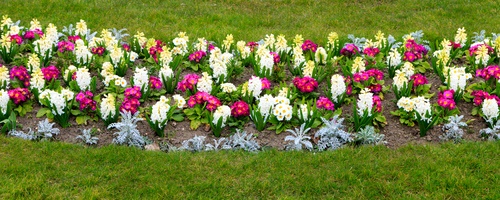
And if you’re still worried about your garden or you feel like your entire yard could benefit from aeration, then don’t hesitate to contact us your lawn experts. Now, let’s get started:
Tips for the Perfect Flower Bed
The perfect flower bed brings together form and function by applying a few simple tips in order to create a whole that’s greater than the sum of its parts.
- Focus on Framing
Part of the “form” part of creating the ideal flower bed for your home is going with a melange of perennials, annuals and shrubs for variety and framing.
In the same way that what’s in the background on a stage set can help to frame all the action going on in the foreground, you want a “framing device” in the back of your flower bed to draw your eye into the action.
A good rule of thumb is to plant tall perennial plants in the back of your garden to get the most out of everything going on upfront.
If you’re on a tight budget or you want to make a simpler landscaping project for yourself, then you can always put shrubs behind your perennials and annuals as well.
- Blend Perennials and Annuals
Annual flowers cycle through the germination, seeding, flowering and expiration process in one single year whereas perennials are able to grow from one year to the next with an off-season of dormancy in the winter.
The good news is that perennials like roses, daylilies, and peonies tend to play nice with annual flowers like marigolds and zinnias when it comes to finding the right balance between earth tones and more vibrant colors for your home garden.
- Combining Earth Tones and Vibrancy
In particular, the pink of a blossoming peony tends to work beautifully with the vibrant red of most roses. Marigolds and zinnias can also work well together if you’re looking to combine more tropical orange and yellow tones into your next flower bed.
Zinnias are actually easier to cultivate than most annuals and come in a myriad of colors that can make any garden really pop and dazzle guests.
You can find zinnias in purple, crimson, rose and scarlet to suit your tastes and make a flowing color combination with actual roses or even peonies when it comes time to get going.
Putting on the Finishing Touches
Once you know the kind of look that you’re going for and how to frame it with shrubs and/or tall perennials, then you want to move onto decorating fences or surrounding wall structures.
For this the beautiful pink and purples of an annual flower like the climbing snapdragon or greens, purples and yellows of passion flower can work very well.
Peony and roses upfront with climbing snapdragon or passion flower snaking along overhanging structures are an awesome want to frame your garden as well as beautify your home and complement your other landscaping efforts.
For help with aeration, irrigation, gardening or regular landscaping maintenance, or just to find out more tips like these, get in touch with DK Landscaping today.
Go Native, Save Water: Xeriscape Gardening
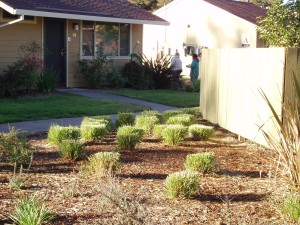 The information age has brought with it a flood a varying techniques in the fields of landscaping, gardening and ecological design. In keeping with the sustainable nature of the best of them, xeriscape gardening is defined by its optimal use of a minimal amount of water. This approach to gardening has been developed in the arid regions in the world, chiefly in the American mid-west, as a natural response to the climate. Xeriscape is most effective when the need for supplemental irrigation is eliminated and the design of the garden promotes symbiotic relationships that provide benefits. Environmental conservancy is xeriscape gardening’s top priority, but aesthetic design has received as much consideration. At its best, xeriscape becomes a melding of both utility and beauty.
The information age has brought with it a flood a varying techniques in the fields of landscaping, gardening and ecological design. In keeping with the sustainable nature of the best of them, xeriscape gardening is defined by its optimal use of a minimal amount of water. This approach to gardening has been developed in the arid regions in the world, chiefly in the American mid-west, as a natural response to the climate. Xeriscape is most effective when the need for supplemental irrigation is eliminated and the design of the garden promotes symbiotic relationships that provide benefits. Environmental conservancy is xeriscape gardening’s top priority, but aesthetic design has received as much consideration. At its best, xeriscape becomes a melding of both utility and beauty.
The Principles of Xeriscape
As conceived by Denver Water, xeriscape gardening’s most revered proponent, these seven guiding principles provide the foundation for all considerations within the field. Each principle holds an entire discipline within itself, which means that there is always more to learn and improve upon in this field.
- Planning and Design are the cornerstones of effective gardening, which requires careful attention to your specific environment.
- Soil Management is about knowing what nutrients your selected plants need and what nutrients are available in the soil. Composting is a great way to reinvigorate malnourished soil.
- Plant Selection is an integral part of xeriscape gardening. Thousands of species exist in arid conditions, each with benefits and beauty to offer.
- Turf Minimalism is crucial because the water needs of most grass lawns makes them impractical for dry climates.
- Diligent Irrigation may be the reason you’re interested in xeriscape gardening to begin with. Water is an invaluable resource and appropriate use of it is essential to environmental conservancy.
- Mulch can be composed of several materials such as leaves, wood chips, pine needles and bark. It is spread over the surface of the soil to help with water retention, fertility, prevention of erosion, and reduction of weed growth.
- Maintenance in the form of weed pulling, mulching, and general upkeep should be combined with constant observation to check if your garden layout is working to its full potential.
The Benefits of Xeriscape
- Reduced Water Consumption is both the key aspect of xeriscape gardening and a great benefit of it. It means using less water and making better use of it. Not only will this save you money, but you will be helping your community and environment as well. Re-appropriating rainwater can help you prevent evaporation and runoff, and your garden’s layout can be optimized for better use of it.
- Less Maintenance is required from a xeriscape garden. Much less fertilizer is used, which helps urban runoff pollution, lawn mowing becomes nigh unnecessary, and simple irrigation systems can handle all of your watering needs.
- Pest Control is an added benefit of a really well thought out garden layout. Certain xeriscape friendly plants ward off insects, while prickly cacti do the same for intrusive mammals. Plant selection also enables you to create a sanctuary for desirable birds and insects.
- Property Values Rise when you drought-proof the terrain around your home. Likewise, the design opportunities available to xeriscape can make for some exquisite gardens.
There are an abundance of tips and tricks available for do-it-yourself xeriscape gardening, but expert consideration reaps the true benefits of the art form. Xeriscape specialists develop an uncanny ability to read an environment and discern its possibilities. With a little help, and dedication to the sustainability principles of xeriscape you could be looking at a lower water and power bill, a productive and efficient garden, and a beautiful area in which to relax.
Front Yard Flower Bed Ideas – DK Landscaping
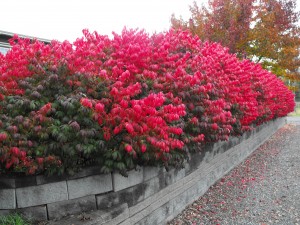 Want to make your home look calm, inviting, and happy? Add flower beds to your property for constant color. Use the beds to delineate property or break up bland expanses of lawn grass and dirt. Finding flower bed ideas is simple, but you should be sure of what you need and why. There are so many possible flower bed ideas that you can get easily bogged down in details if you start to look for designs without taking issues like drought and level of care into consideration. Pinpoint non-negotiable issues like those first to make designing your front yard a lot more efficient.
Want to make your home look calm, inviting, and happy? Add flower beds to your property for constant color. Use the beds to delineate property or break up bland expanses of lawn grass and dirt. Finding flower bed ideas is simple, but you should be sure of what you need and why. There are so many possible flower bed ideas that you can get easily bogged down in details if you start to look for designs without taking issues like drought and level of care into consideration. Pinpoint non-negotiable issues like those first to make designing your front yard a lot more efficient.
Drought-Proof Flower Bed Ideas
Drought is probably going to be one of your main considerations when looking at flower bed ideas. Many areas of the country are experiencing water shortages, and anything you plant has to be able to deal with a lack of abundant water. That doesn’t mean you have to plant cacti — just look for cultivars of flowers that have been bred to be less water-needy. Native flowers are always a wonderful choice in this case as they are already somewhat adapted to their region’s fluctuating water supplies. Plant breeders have been working on drought- and disease-resistant cultivars of all sorts of plants for years, and it’s become easier to find these in garden centers and from landscaping companies when looking at flower bed ideas.
Easy Care Flower Bed Ideas
Ease of care is another big consideration for flower bed ideas. Even if you have a landscaping company taking care of most of your garden, you’ll still have to do some minor care yourself. If you don’t feel up to that, you’ll want flower varieties that can handle benign neglect. Again, native flowers tend to be a little better for this, though there are easy-care species from all over the country if you’d like more variety for your flower bed ideas.
Location Ideas For Your Flower Bed
Now take a look at location to further refine your flower bed ideas. Flower beds that will be near the street need to be able to handle road salt spray, for example, if your area tends to have occasional snowfall in spring or fall. That’s not so much of a problem with annuals, as you’d be removing them anyway, but if can be for perennial or biennial flowers.
Flower bed ideas for spaces near fences can have species of varying heights, so those plants nearer the fence should be taller. The shorter flowers near the edge of the bed may need to be shade-tolerant if the bed is positioned where the fence or taller plants might block a lot of the sunlight.
Reduce Insects
Flowers planted next to the house need to be pest-resistant if possible. While it is impossible to guarantee that a flower will never attract a bug, if you have flowers that tend to attract pests, those pests could get into your house. Ask your garden center or landscaping company to show you flowers that have a reputation for repelling insects, too, such as marigolds, petunias, and nasturtiums. As you come up with ideas for other areas of your yard, you can work a few of these plants in so that you can reduce the number of pests you have to deal with overall. Start talking to landscape design companies about flower bed ideas and species that fit what you need for your yard’s environment, and you’ll have a beautiful yard in no time.
Stop and Smell The Flowers!!
Flowers! From incredible wedding bouquets and beautiful Mother’s Day arrangements to blooms we offer in the hope of soothing hurt feelings, there are many occasions and reasons for why we plant them and offer them as gifts. So As you begin to paint the picture of your landscape plan, take a moment to consider their meaning before you begin to plant. Here are a few of the most popular floral choices and the meaning that they convey:
Roses 
There is no flower that has been revered and celebrated as much as the rose. As a source of inspiration to people throughout history, roses are the definitive symbol for love and appreciation, but the different colors also have a meaning all of their own:
Yellow roses mean joy ~ Red roses mean passion ~ Burgundy roses mean unconscious beauty ~ Orange/coral roses mean desire ~ Red and white roses together mean unity ~ Pink roses mean grace and gentility ~ White roses mean worthiness
Orchids
With an exotic appearance, orchids have come to represent rare and delicate beauty. Those seeking to make a lasting impression with a unique flower have found the orchid to be a perfect choice. As both potted plants and cut flower arrangements, these tropical flowers have an undeniable appeal. Different cultures throughout history have believed in the healing, disease-fighting and protective properties of the orchid. In traditional Chinese medicine the orchid is used to help cure coughs and lung illnesses. The ancient Greeks associated it with virility, and the Aztecs were said to drink a mixture of the vanilla orchid and chocolate to give them power and strength.
Lily 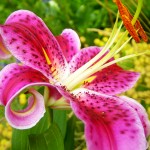
A very common flower at funerals, lilies also symbolize virtues such as purity, sweetness and friendship. The Greeks believed the lily sprouted from the milk of Hera, the wife of Zeus. White lilies signify purity and sweetness, day lilies symbolize coquetry and yellow lilies can mean falsehood or gaiety. Lilies of the Valley mean a return of happiness.
Iris Flowers
Few other flowers can match the elegant beauty of the iris. Representing faith, hope, and wisdom, the iris is a flower that can be used for many different occasions. While it is most known for its distinctive blue varieties, the iris can also be found in other colors such as yellow and white.
Tulips
With their flower meaning being perfect love, tulips can impart a sense of grace and elegance wherever they are displayed. The tulip is recognized throughout the world as one of the most popular cultivated flowers, but they are particularly associated with the Netherlands. Dutch tulips are among the leading tulip varieties within the floral community.
Carnation
As one of the most popular flowers in the world, the carnation is widely appreciated and enjoyed. Carnations are available in a variety of colors and are generally symbolic of love and fascination.
- Red carnation symbolizes love, pride and admiration
- Pink carnation symbolizes the love of a woman or a mother
- Purple carnation symbolizes capriciousness;
- Yellow carnation symbolizes disdain, rejection or disappointment
- White carnation symbolizes innocence and pure love
- Striped carnation conveys refusal
DK Landscaping are your landscaping and gardening experts. If you need a company to spruce up your existing landscape or custom design one, call us.. DK Landscaping serves Petaluma, Cotati, Rohnert Park, West County, Santa Rosa and Windsor areas. Call us today ![]() 707.280.3632.
707.280.3632.
Fall Landscaping Tips and Tricks
Sonoma County embraces the fall season as temperatures begin to dip and daylight begins to wane. It marks a time of change when our summer perennials and annuals die back, the leaves fall from the trees, and our irrigation systems get turned down.
Fall is an opportune time when we should welcome a change in landscape by dressing up your yard with some of fall’s favorites like mums, gourd’s, pumpkins! They are everywhere, in a variety of colors, from yellow to deep red.

MUMS are inexpensive and can be purchased just about everywhere. They make for great boarders, or can be planted in mass for a striking display. And the best thing, they are hardy perennials and can withstand low temperatures and frost. If planted early enough they will come back next spring. As an alternative to mums, you can use Coleus, Sedum, Firethorn, Snap Dragons, and Pansies to add stunning beauty to your landscape. Throw a few pumpkins in the mix and you’ve got a gorgeous garden display.
TREES are another way to spruce up your landscaping. They are not only beautiful but require less work than your summer-time trees. DK Landscaping recommends Hickory, redbud, sugar maples, and birch trees create marvelous landscapes of fall color. 
Lastly, don’t forget to incorporate hay bales, pine straw, pumpkins, gourds, cornstalks and potted plants – all that the harvest season has to offer!
Just following these simple fall tips and tricks will make your landscape pop with color, and keep your landscape looking beautiful and colorful all season long. It will make your home extra inviting for visitors including some little ghosts and goblins on Halloween night.
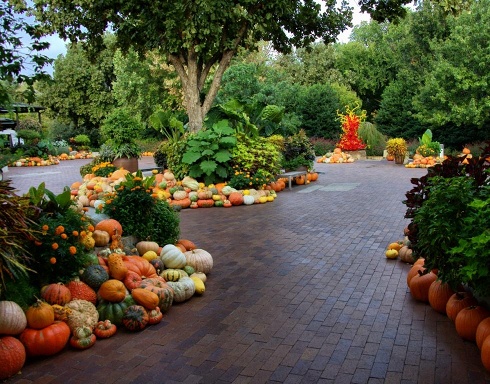
DK Landscaping is your Northern California’s premier’s landscaping company. For more information and/or a free consultation how we can add a little color to your fall life, please give us call (707) 280-3632.






